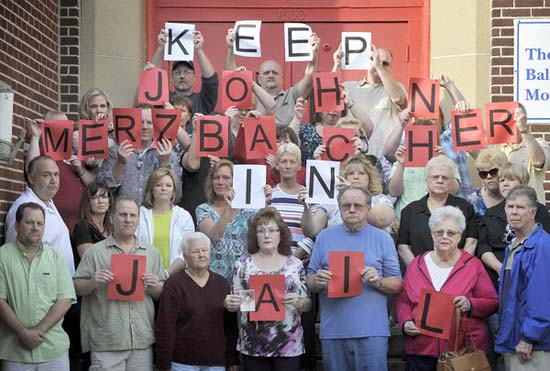
Victims and Merzbacher and some family members of the victims
Archbishop Lori has written a column, “Remembering the painful past,” in Baltimore’s Catholic Review. He summaries the case of John Merzbacher, who abused dozens of children at a Catholic elementary school in south Baltimore, a school where Sister Eileen Weisman was principal. His version does not jibe with what the victims said or what was said to parents:
From my book, Sacrilege:
One alleged victim said that he saw Merzbacher having intercourse on a table with Sister Eileen Weismann, the principal of the Catholic Community Middle School at which he taught from 1972 to 1979. Several plaintiffs said that Merzbacher bragged about it: “Privately he would say he would have to fuck her so that he could do what he wanted in the school.”
His former students said that Merzbacher had a gun in his desk; he once held it to a victim’s head when he molested her. He had sex, according to the plaintiffs, with many boys and girls during and after school. Sister Eileen, the plaintiffs said, saw the molestation and did nothing. The students were terrified into silence after Merzbacher convinced them that he had Mafia connections. Gary Homberg, who taught at the school with Merzbacher, gave an affidavit in which he said, “I personally observed John Merzbacher sexually touching, molesting, and fondling both male and female students.” After one student came to Homberg to tell him that Merzbacher “was raping him and threatening to kill him if he ever told anyone,” Homberg called a meeting at his house with Sister Eileen, the Rev. Herbert Derwart, another priest, and told them what had happened. The three archdiocesan employees met privately, and then told Homberg “that they would like me to continue as a teacher in the school, but only under the condition that I made no mention to anyone of my observations on John Merzbacher’s sexual misconduct.: Homberg resigned his teaching position, but he did not tell anyone of Merzbacher’s conduct because he was afraid of him.
[Note that this meeting must have occurred during Merzbacher’ tenure at the school, from 1972-1979.]
Sister Eileen Weisman later became principal of the school of the Cathedral of Mary Our Queen. When the Merzbacher story broke, she spoke to the assembled parents at the Cathedral School and said only, “My conscience is clear.” The parents applauded her. Weisman never said what she knew about what was going on in her former school. Neither the prosecution nor the defense called her as a witness, although the defense attorney had said in his opening statement that Weisman would be called. The trial was terminated abruptly when both sides unexpectedly agreed to stop calling witnesses, even though the defense had not developed the arguments it had laid out in the opening statement. Merzbacher was convicted on one charge, but all other charges were dismissed, which means that if his conviction is overturned on appeal on a technicality, he cannot easily be tried on the other charges, Therefore, Weisman faces little possibility of being called to testify (and in an case she moved to Rome in 2003).
Merzbacher is appealing his conviction because his attorney did not transmit a plea bargain offer to him. If the conviction is overturned, it will be almost impossible to retry him, as the other charges were dismissed with prejudice.
Lori in his column says:
The archdiocese first learned of the abuse in 1988, when one of Merzbacher’s victims reported it to the archdiocese.
This does not jibe with Homburg’s account, although perhaps Lori give “The archdiocese” a special meaning that excludes employees of the archdiocese. Homberg had no reason to lie; if any archdiocesan employees were involved in a cover-up, they had every reason to lie.
Lori adds something new to the story:
In 2002, the year the scope of the church’s sexual abuse crisis came into view with Boston serving as the “epicenter,” the archdiocese’s Independent Review Board, a group of nine lay people of different faiths and backgrounds, none employed by the archdiocese, charged with reviewing the archdiocese’s handling of child abuse cases, reviewed the Merzbacher case. It did so because it was concerned that Sister Eileen Weisman, S.S.N.D., who had been principal at Catholic Community School during the years John Merzbacher abused students, was in 2002 the principal of the School of the Cathedral of Mary Our Queen. The board reviewed the court documents and unanimously recommended to Cardinal Keeler that Sister Eileen not remain in her position and not be employed in any position within the archdiocese that involves overseeing the safety of children. Cardinal Keeler agreed with the recommendation and contacted Sister Eileen’s superior. Sister Eileen would announce her retirement shortly thereafter and has not worked or volunteered in the archdiocese since.
This is interesting. Parents in the parish and the school were never told the real reason why Weisman left, according to Cathedral parents I have spoken to; they were told that Weisman was going to an important position in Rome. She is still there, beyond the reach of the courts of the United States.
Toward the end of Sister Eileen’s tenure as the Cathedral school, Rev. Thomas Rydzewski became an assistant at the Cathedral and spent a great deal of time with the children of the lower grades of the school. He was a child pornographer; he was arrested in December 2001 and was convicted, he was supposed to be imprisoned, but my sources have seen him enjoying the hospitality of St. Luke’s Institute in Suitland, Maryland.